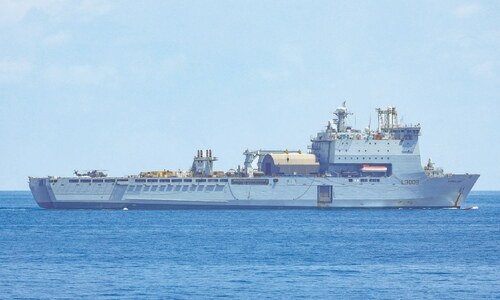ITS eyes fixed on the bonanza that the China-Pakistan Economic Corridor promises to bring, the Khyber Pakhtunkhwa government has formed a company to develop special economic zones and has identified sites for four zones to attract industrial investment.
On December 15, the first of these zones was opened at Hattar, with hopes that it will lead to Rs300bn of investment inflows over the next five years.
But Hattar has already been an industrial area for decades and is located next to the vast Taxila industrial complex. And so are Nowshera and D.I. Khan, where two other special economic zones (SEZs) have been proposed. Only Karak will be a new industrial estate, inspired by Punjab’s Sundar industrial estate.
The company plans to set up dedicated special economic zones in Swat and Malakand divisions to promote small industries, says its CEO Mohsin M. Syed
Meanwhile, factories have been closing down in KP’s old industrial estates owing to a lack of sustained and adequate supply of electricity and gas and an enabling environment.
Currently, there are 17 industrial estates in KP, including seven medium- and large-sized ones. All of these are managed by the Sarhad Development Authority (SDA). The remaining 10 are small-sized estates.
No funds were allocated to upgrade or revive the dilapidated infrastructure in the existing estates during the nearly past three years of the PTI-led provincial government. And successive provincial governments failed to convince the federal government to provide competitive tax incentives to attract investment in these zones.
Consequently, 415 units out of 646 industrial units in the four industrial estates of Hayatabad (Peshawar), Gadoon Amazai, Hattar and Nowshewra have shut down. Over 20,000 workers were retrenched. Meanwhile, the rest of the 231 units are struggling in an unfavourable business environment.
And 449 out of 247 units in the nine other industrial estates in the province have also closed down, retrenching more than 5,000 workers.
But no corrective measures have been taken to stop more industrial units in these estates from going under. A major issue is the overlapping of the responsibility of various departments in attracting and facilitating investments in the province.
Meanwhile, apart from ensuring stable supply of utilities, the provincial government will also have to engage the federal government to ensure customs duty exemption on the import of capital goods, machinery and equipment for the setting up of industry in the province, as well as income-tax exemption for a certain period.
The CEO of the KP government’s Economic Zone Development and Management Company (EZDMC), Mohsin M. Syed, is optimistic that the four identified sites will be able to attract investment. He says one-window services, including water, gas and electricity connections as well as proper security, will be offered to investors.
So far, the KP government appears to have not given much thought about exporting fruits and vegetables to China under CPEC. China has a ready market for farm produce and dairy products. Swat, Dir and Chitral are famous for their fruits and vegetables, but lack cold storage and packaging facilities.
The Nowshera expansion/Jalazai economic zone will cover 287 acres of land and is expected to house marble-cutting and polishing industry, as well as mosaic furniture and construction material vendors
Mohsin says EZDMC plans to set up dedicated SEZs in Swat and Malakand divisions to promote small industries. One such zone will be established near the Dargai hydropower station so that cheaper electricity could be provided to investors.
As per details, the Hattar Phase 7 SEZ will be developed over 424 acres of land and target sectors like food, pharmaceuticals and engineering. Mohsin says 30 factories will become operational by the end of 2016, while the auctioning of plots will commence from March.
The company estimates that the SEZ will generate 30,000 jobs. The zone will require 100MW of electricity and also need a vocation centre to train 5,000 youngsters. The cost of the project is Rs2.138bn and it is expected to be fully completed by 2017.
The second SEZ will be developed over 1,000 acres along the M-1 Motorway in Nowshera near Rashakai. It aims to attract foreign investment in auto, fruit/food packaging (for export purposes) and textile value-addition (stitching/knitting) sectors. The company estimates an investment of Rs1000bn in the zone. It will provide employment to 50,000 people. The zone will need 225MW of power and vocational training centres to train 10,000 youths.
The Nowshera expansion/Jalazai Marble and Mineral Economic Zone will cover 287 acres of land and is expected to house marble-cutting and polishing industry, as well as mosaic furniture and construction material vendors.
The SEZ at Dera Ismail Khan will be established over an area of 200 acres. It will house date-packaging and processing facilities. The expected investment in the zone is Rs30bn and it will create 20,000 jobs. Other areas for investment in the area include herbal medicines (turmeric/aloe vera) and agricultural implements. The zone will require vocational training centres to train 1,000 youngsters.
Meanwhile, an oil refinery with a capacity of 100,000 barrels per day will be established at the SEZ in Karak at a prospective investment of $5bn. It is expected to create 5,000 jobs. A 1,000MW gas-based power plant will also be established at Karak with an investment of $10bn over the medium-term.
The KP government plans to establish a carpet-weaving industry near Peshawar at an investment of Rs100bn, which will create jobs for over 2,000 technical and non-technical positions.
It is also planning trucking, logistics and cold storage parks for CPEC projects at Sust, Mansehra, Havalian, Peshawar, Bannu and D.G. Khan. Each park is estimated to be over 100 acres of land and cater to 500-1,000 trucks travelling along the CPEC route through KP.
Published in Dawn, Business & Finance weekly, December 28th, 2015














































